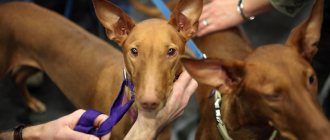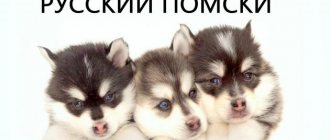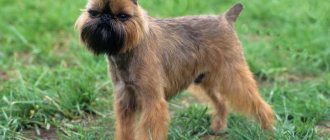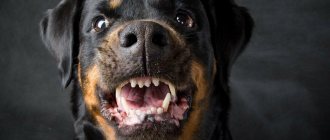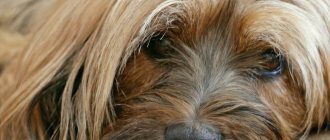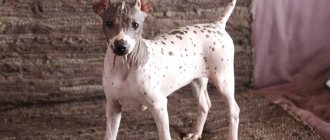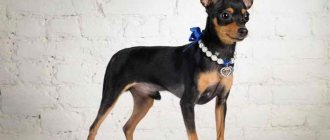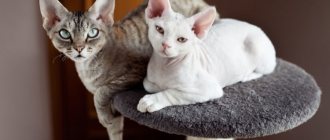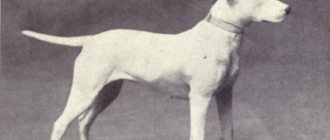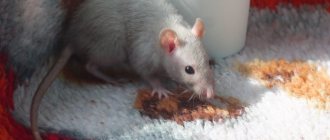Description and appearance
This dog breed is distinguished by its muscular body, bright coat color, and calm and confident expression in its eyes. It should be noted that the Moscow Guard Shepherd belongs to a young breed group (bred in the 50s of the last century), but is loved and very popular among different categories of dog owners.
The Moscow Guard Shepherd belongs to the young breed groups
Temperament and character
The Moscow Watchdog is a working dog with moderate viciousness , so they devote a lot of time to training. There are individuals that are dominant in character.
Positive qualities of Moscow watchmen:
- Living thinking;
- Fast decision making;
- Unobtrusiveness;
- Equilibrium;
- Ability to learn;
- Loyalty to the owner;
- Working quality is at a high level.
Negative features:
- Independence;
- Stubbornness.
Breed standards
The history of the breed begins in the mid-twentieth century, when the main parameters of the Moscow guard dog were outlined:
Advertising:
- The height of males at the withers starts from 68 cm, for females the count starts from 66 cm. The upper limit of height is not established; in proportion, the height at the withers is higher than at the rump;
- the weight of a purebred male is from 55 kg, and females are usually 10 kilograms lighter,
- broad-browed, heavy head with a clearly defined transition to a voluminous muzzle;
- slightly saggy lips (necessarily black);
- the neck is short, but massive with slight weight;
- the ears are triangular in shape and also droop;
- eyes are round, dark, widely set;
- The front and hind limbs are equal in length to half the height of the dog at the withers. Paws are round, large;
- the coat is thick, long, with a close-lying undercoat;
- the tail is set high and looks like a wide sickle.
The history of the breed begins in the mid-twentieth century, when the main parameters of the Moscow guard dog were outlined.
In the photo of the Moscow guard dog, attention is drawn to manes of wool and fluffy tails. These details emphasize the peculiarity of the breed, bred for service in areas with harsh climates.
Colors
The color of the coat of the Moscow Guard Shepherd is bright and rich. According to the standard, these are dogs with a white-red or white-red-brown color and the obligatory black markings on the face and ears. The so-called glasses are symmetrically located and completely cover the eyes, and are separated by a white stripe of fur in the very center of the head.
A distinctive feature of the color is the white end of the tail, as well as the whiteness of the chest, collar area, paws: the entire length of the front paws and the rise to the shin - the hind paws.
The coat color of the Moscow Guard Shepherd is bright and rich
Character
Behind the enormous size with which the Moscow Watchdog breed stands out, there is a hidden character that manifests itself differently depending on the situation and environment. Initially, this dog was bred for reliable protection and service at the most critical sites. Therefore, as a watchman she is distinguished:
- ability to train;
- intelligence and instant reaction;
- performance and endurance.
For the family with whom the Moscow Guard Shepherd constantly communicates, it can be submissive, very affectionate towards all family members, and playful. But it is better for outsiders not to test her character: aggressiveness and hostility towards strangers will fully manifest themselves. Usually calm, balanced, silent, the dog will burst into menacing barking and show unpredictability.
For the family with whom the Moscow Guard Shepherd constantly communicates, it can be submissive, very affectionate towards all family members, and playful
All habits of animals of this breed directly depend on the quality of training and perseverance of the owner, because the difficult aspects of keeping a shepherd include its unmotivated stubbornness.
Photo
The Internet is filled with numerous photos in which the Moscow guard dog is presented in all its power and beauty. It’s as if the owners are competing to see whose pet looks more impressive and representative. But for a certain category of network users, it is not the adult Moscow watchdog that is of particular interest, but photos of puppies of this breed, when they look more like fluffy bear cubs, creating comfort and peace.
Lifespan
With proper care and disease prevention, the lifespan of a Moscow guard shepherd dog reaches 12-13 years. The lower limit is indicated by 9-10 years under other circumstances.
Reviews from the owners of the Moscow Watchdog
The Moscow Guard is a high-quality purebred dog that will become an unrivaled guard. However, such a pet is quite serious; it requires a lot of effort to raise an obedient and devoted dog.
Content
The owner of a spacious house, without a doubt, can own a large breed of Moscow guard dog, since this animal needs a large territory.
When kept in an enclosure, the pet will still need walks with the owner to strengthen training skills. The apartment in which the dog lives must be arranged so that the shepherd can move without problems. The owner must take care of the absence of drafts, convenient placement of bowls for food and water, and for Moscow Watchdog puppies, the presence of toys is a must.
When kept in an enclosure, the pet will still need walks with the owner to strengthen training skills
Significant physical activity is extremely important for this breed of dog. Walking twice a day (an hour or more) involves intensive jogging, playing with objects, and special exercises.
Education and training
For Moscow watchdogs, they do not require passing exams to determine working qualities or temperament testing, but it is advisable to pass OKD and ZKS if the dog is put under guard.
Guard duty begins when the pet is completely under control. Otherwise, an angry dog becomes dangerous. This applies to any breed.
Muscovites quickly learn the program, but do not welcome mindless repetitions of the same command. The dog will simply refuse to comply with the owner's demands. Like many Molossers, representatives of this breed rarely agree to wear fetch.
Clear advantages include their interest in protecting their own territory. They begin to guard strangers early; puppies from 7-8 months of age bark at strangers behind the fence.
In the city, a dog of this type can be trained and taken for walks, because Muscovites do not need too active games. The main task for them is to serve man, and their punishment is to be ignored by their beloved owner.
Care and hygiene
One of the main characteristics of the Moscow Watchdog breed is its unpretentiousness in maintenance. But several hygiene procedures are mandatory:
- Luxurious coat care (combing weekly, more often if necessary; treatment with insecticides).
- Prevention of worm infection.
- Bathing is infrequent (several times a year).
- Regular examination of the ears, eyes, and nasal mucosa for the presence of discharge - chamomile decoctions or brewing tea solve the problem.
- Trimming nails of apartment dogs.
- Routine vaccination.
The diet of dogs of the Moscow Guard Shepherd breed does not differ significantly from the diet of other large individuals with predatory instincts.
Observing the pet’s behavior and quickly responding to changes in habits allows you to avoid problems with care.
Attitude towards children and others
The Moscow Guard Dog is non-aggressive; She treats children well and even tolerates many of their pranks. But it’s still not worth leaving it alone with the child - being distinguished by its impressive size, it can unintentionally harm the child. However, under the supervision of adults, this dog is a real find for parents: they enjoy playing with children, and in the winter they even enjoy taking them on sleds.
The dog behaves warily towards strangers, watching their every move when they are outside the threshold of their home. Aggressive behavior on their part is observed extremely rarely: despite the fact that these dogs are recognized as excellent defenders and guards, they can only raise their voice in a situation of extreme necessity.
What to feed (by month)?
The diet of dogs of the Moscow Guard Shepherd breed does not differ significantly from the diet of other large individuals with predatory instincts. It is usually twice a day and is aimed at preventing allergies and obesity.
For an adult animal it is recommended:
- lean meat (more than half a kilogram per day);
- boiled offal;
- fish - no more than 2 times a month;
- rice, buckwheat porridge every day up to 400g;
- dairy products – up to 4 liters per week;
- chicken egg (no more than 2 per week);
- bones with cartilage, tendons;
- vegetables and fruits in season.
Experienced owners of this breed advise providing their dogs with vitamin supplements. In some situations, it is possible to feed commercial diets, and then it is optimal to choose premium or super-premium food.
In order for the Moscow Guard puppies to grow into a beautiful and strong adult dog, you need to follow these tips month by month:
- at the end of the 1st month of life, complementary feeding from small pieces of beef (minced meat is not recommended), then continuously;
- 1−3 months of life for drinking - goat's milk;
- at 2 months you can offer dry food for chewing;
- up to 7 months of age, kefir and cottage cheese should also be given every day; alternate porridges, fish and fresh chicken yolks once a week.
Experienced owners of this breed advise providing dogs with vitamin supplements.
It should be remembered that the volume of food puppies should be one fifth of their weight. While young animals are growing rapidly, supplements of vitamins and minerals are advisable. The number of meals decreases by the age of eight months to 3-4 per day.
It will be interesting for those new to communicating with dogs of this breed to know that there are special periods in the life of their pets when attention to the diet is required: this is molting (you need to feed the animal with food sulfur and methionine to restore the coat). In winter, more liquid and fatty foods, preheated and enriched with vitamin D, are desirable. At the age of six, nutrition should be revised in the direction of increasing nutritional value. As a dog grows, its body requires calcium supplements.
Nutrition
Obviously, such a giant is capable of eating twice as much food as any other dog. Therefore, maintenance will be more expensive. If you were counting on a little one, a Muscovite is not your option. The standard diet is lean meat or meat trimmings, cereals, offal, vegetables, bran and herbs.
Boiled fish and fermented milk products are periodically added to this. Babies begin to be fed cottage cheese, boiled vegetable puree, oatmeal and buckwheat porridge. Each new product is introduced carefully and gradually, due to the danger of allergies.
You should not feed mushrooms, legumes, sweets, flour products, chicken bones, river fish, or hot, salty, and spicy foods at all. Add the necessary vitamins and microelements. If you decide to stop at factory feed, choose an option for large breeds, and a good one at that.
Diseases and breed defects
An important characteristic of the Moscow watchdog is its good health and remarkable endurance. But a massive physique and large weight provoke the appearance of:
In winter, more liquid and fatty foods, preheated, are desirable.
- dysplasia of the hip and elbow joints;
- food allergies, obesity;
- heart failure;
- dermatological problems.
The manifestation of symptoms of these diseases will prevent proper care of your pet.
The breed's defects are obvious even when looking at the Moscow Watchdog puppies in the photo:
- lack of a powerful torso;
- asymmetry of dark spots on the eyes;
- narrow muzzle;
- the color of the coat does not correspond to the standard (including inclusions of white).
As a dog grows, its body requires calcium supplements.
Behavioral defects include lethargy, apathy, and cowardice of the animal.
Pros and cons of the breed
When you decide to have a pet in the form of a purebred dog, choose the type that suits you. If you have enough time to devote to your dog, if you have the willpower and the ability to keep a large animal, pay attention to the Moscow watchdog. The main pros and cons of representatives of the breed are outlined below.
Advantages:
1. Developed protective and security instincts. 2. Devotion, fearlessness. 3. Love for children. 4. Balance. 5. Pet Friendly. 6. Rarely barks. 7. Good health. 8. Ability to withstand severe frosts. 9. Can be kept in an enclosure.
Purchase and price
Many of those who saw photos of the Moscow Watchdog at the age of puppies were touched and began to look for options for purchasing dogs of this breed. But it is important to seriously evaluate your chances (character traits, living conditions, financial capabilities) before purchasing such a large animal.
Before purchasing, you need to think again about what role you will assign to your future pet: a loyal friend or an uncompromising guard.
If you need a buddy, choose the puppy who quickly made contact with you. And an outwardly distrustful, even gloomy dog will claim the role of watchman. For protection, mother certificates and supervision of her work are required, since many habits of this breed are transmitted genetically.
When purchasing, it is better to contact breeders who have experience and know all the intricacies that the Moscow Guard Shepherd has.
Based on reviews on the Internet, check for a nursery with a decent reputation and take advice from a specialist on problematic issues.
It should be remembered that the volume of food puppies should be one fifth of their weight
The price that will be assigned for Moscow Watchdog puppies will vary depending on the accuracy of compliance with the breed standard: from 6,000 (weak color pigment, slight curly coat is allowed) to 60,000 rubles (with ideal external data and response to training).
Dog and man
The Moscow Watchdog is suitable for self-confident people who value the strength and intelligence of a dog. They are excellent guards, prefer to be outside, and love work. They are of little use for sports due to their physique, working qualities and unique thinking, which is characteristic of all Molossoids. Most often, Muscovites are adopted by experienced dog breeders .
They are affectionate with children; they take cats and other pets under protection or have a neutral attitude. They can live in an apartment where they take up little space, but then a full and long walk is necessary. In the house they most often doze off in a familiar corner, but their sleep is light.
Reviews
Natalia: “My acquaintance with this breed took place a long time ago and first through a book: I came across a fascinating article about dogs, and on the page I saw a photo of Moscow guard dogs. Coincidentally, we moved into our own house and were looking for a guard animal. Couldn't have made a better choice! At first, slightly clumsy, like all kids, the creature gradually turned into a stately shepherd with amazing-to-touch fur, a strong body and humanly intelligent eyes.”
When purchasing, it is better to contact breeders who have experience and know all the intricacies
Vitaly: “I heard a lot about the Moscow Watchdog breed from a work colleague, and I saw it with my own eyes when I helped lay tiles at the dacha. I even really envied my partner how easily he communicated with such a powerful dog. The dog treated me with distrust as a stranger and did not ignore a single move of mine. And when my grown-up son ordered a dog as a gift, he decided to get this breed of shepherd. The new family member, of course, first damaged the wallpaper and shoes. But now, at the age of three, it helps my son and I to be patient and persistent, because without constant training there is little use. This is how we educate each other.”
Oleg: “I took a risk and started a Moscow watchdog in the apartment. My wife and I didn’t think that there would be so many advantages. We go for walks every day: in the morning, taking turns, in the evening, together. The weekend has become a real holiday - we go out of town with friends. Life began to sparkle with bright colors.”
Key points in training
The Moscow Watchdog is prone to dominance and displaying its character. Obedience can be achieved without harsh methods, showing your superiority. For example, you should not feed your pet until the family has finished eating. Or not allowing the dog to do what he wants. Brute force is no help. This is how you can raise an uncontrollable aggressive dog.
The puppy needs to be accustomed to a daily routine, feeding and walking schedule. In addition, the dog must know its name well and follow basic commands:
- "near";
- "it is forbidden";
- "place";
- "voice";
- "quiet".
Read about how to properly train a dog in the article: “Training a puppy: effective methods from dog handlers, learning commands at home.”
How to choose the right guard dog
When choosing a guard dog, pay attention to the service breed. Already from the name it is clear that they have security skills that will help make decisions in a critical situation.
They are characterized by a calm character, a stable psyche and a predisposition to training. If you want your pet to serve not only as a watchdog, but also to be a friendly friend, then it is best to choose a medium-sized breed with a low level of aggression.
Differences with St. Bernard
Are Moscow Watchdog and St. Bernard not the same thing?
Since these two breeds look very similar to each other, we hasten to dispel this myth - they are not the same breed. St. Bernard is the progenitor of the Moscow watchdog, therefore the external color and size are extremely similar.
What is the difference?
Saint Bernards are very massive by nature - the weight of these dogs can reach eighty kilograms, and their height can be up to seventy centimeters at the withers. Therefore, their closest relative is also considered a large breed. The height of the Moscow watchdog is also about 60-70 centimeters, but the dog itself is much narrower and drier in the body than its ancestor. Therefore, the usual weight for this breed is 45-50 kilograms.
Try to find the differences between the Moscow Watchdog and the St. Bernard in the photo comparison:
The St. Bernard's head is wider and larger, and only one specific type of color is allowed for this breed. However, if you look at it from the other side and pay attention to the tail, the Moscow watchdog’s tail is not capable of curling into a donut, more even than that of its ancestor.
The main external highlight of the St. Bernard has always been considered to be deep, seemingly sad eyes and large ears hanging right down to the end of the muzzle. His ancestor did not inherit such long ears - usually their length is limited to the zygomatic cavity, and there is no wide lower eyelid, creating the effect of “sad eyes”.
Saint Bernard
The most important and important difference between these two breeds is their character . Saint Bernard is a breed recognized all over the world, has an unusually calm and balanced disposition, is good-natured like a teddy bear and is able to come to a person’s aid, despite its impressive size.
The character of the Moscow watchdog differs significantly. A dog of this breed was bred specifically for protection, because it is more willful, can show rigidity in behavior and show aggression. In the absence of proper training, this breed can cause a lot of problems both for the owner and for the people around him. However, this does not mean that she is evil! No - this is an active but strong animal that needs to be taught to communicate!
Moscow watchdog
If you still compare the main traits of their characters, the St. Bernard is suitable for a family with children , he will not offend or bite members of his “pack,” and the Moscow watchdog should be taken to a house where a guard is really needed .
The similarity of these breeds is that they are very unpretentious and not capricious in their maintenance - both in feed and walking rules. The main problem of these two dogs can only be the presence of thick hair, which is not very easy to comb out and bring into proper shape every time they shed.
Price: how much does a puppy cost?
There are many nurseries that offer interesting deals. Buying puppies from a nursery, of course, will cost much more, but you get a guarantee that you are purchasing a “Muscovite” and not a mixture of breeds. This puppy will carry the genes appropriate for the breed. Also, all puppies from the nursery are healthy and without developmental disorders.
On the market and through advertisements, it makes sense to buy puppies only to save money, but at the same time you need to be prepared to stumble upon a crossbreed. In such cases, it is advisable to look at the parents, but still, in the absence of documents, it will be difficult to make a claim to the seller.
The average price for a second hand purchase is 15,000 rubles. In nurseries - 20,000 rubles.
REFERENCE! Sometimes large nurseries hold promotions, selling purebred dogs at a lower price.
Is he afraid of shots?
The dog is not afraid of shots, which means it can be an assistant during the hunt, when guarding military enterprises, and noisy industries.
How long do they live?
Moscow watchdogs live relatively short, like most large dogs, from 8 to 10 years.
